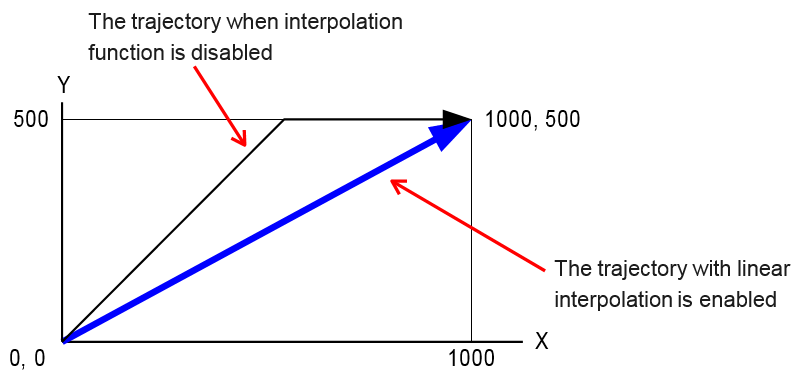Linear Interpolation
Linear interpolation is when two or more axes works together to cause movement along a straight line. For linear interpolation, each axis moves in only one direction, and start and stop at the same time. The X, Y, Z, and U commands can be combined into a single move command. Any combination of axes can be used for linear interpolation, and at least two axes must be referenced in order to perform linear interpolation. Only one linear interpolation set can be executed at a time. 
By default, interpolation is enabled (EINT=1). While interpolation is enabled, linear interpolation operations are performed by writing positioning commands of multiple axes on the same line. There is no dedicated command for linear interpolation. If interpolation is disabled (EINT=0), writing positioning commands of multiple axes on the same line will not result in an interpolated move.
|
Command |
Description |
Available with: |
Link |
|||||
|
ASCII |
Standalone |
CMD-4CR |
PMX-4EX |
PMX-4ET |
PMX-2ED |
PMX-2EX |
||
|
EINT |
EINT |
Interpolation enable |
● |
|
|
|
|
|
|
IX:Y:Z:[speed] |
|
Interpolation move within buffer |
● |
● |
● |
|
|
|
|
IX:Y |
|
|
|
|
● |
● |
||
|
IACC |
|
acceleration setting for buffered interpolation moves |
|
● |
● |
|
|
IACC |
|
XYZU |
XYZU |
Interpolation move used with EINT |
● |
|
|
|
|
|
|
XYZU |
XYZU |
Interpolated move |
|
● |
● |
|
|
|
|
XY |
XY |
Interpolated move |
|
|
|
● |
● |
|
The black dots indicate the command is available on the listed controller family.
